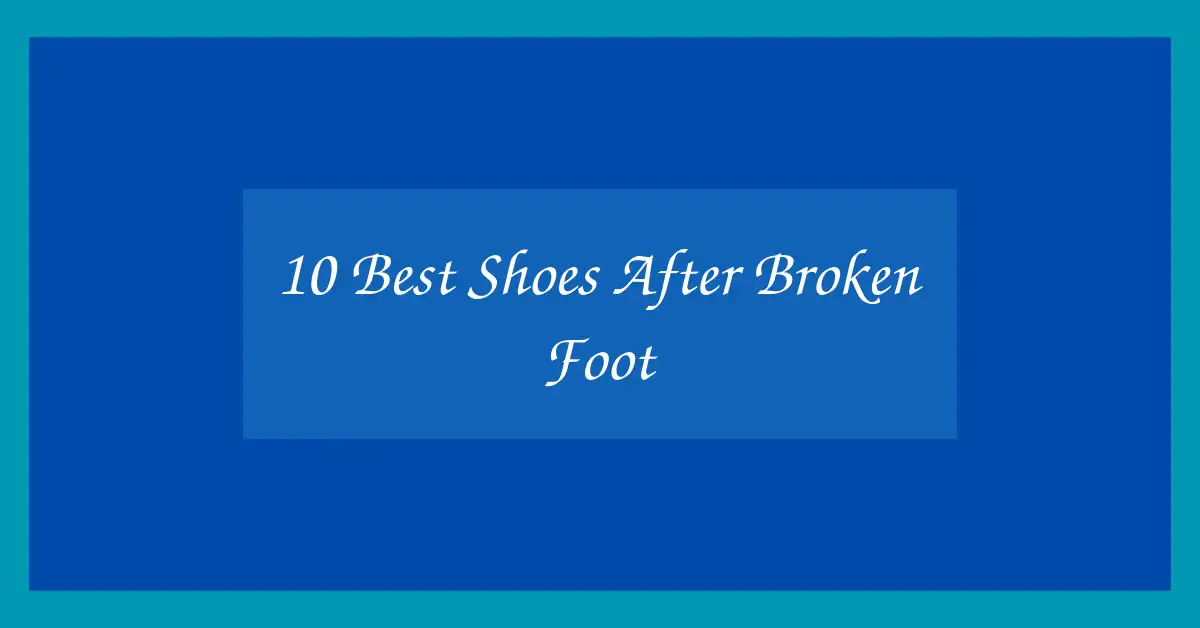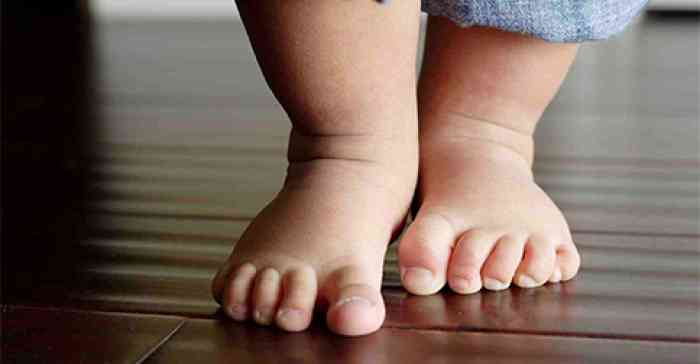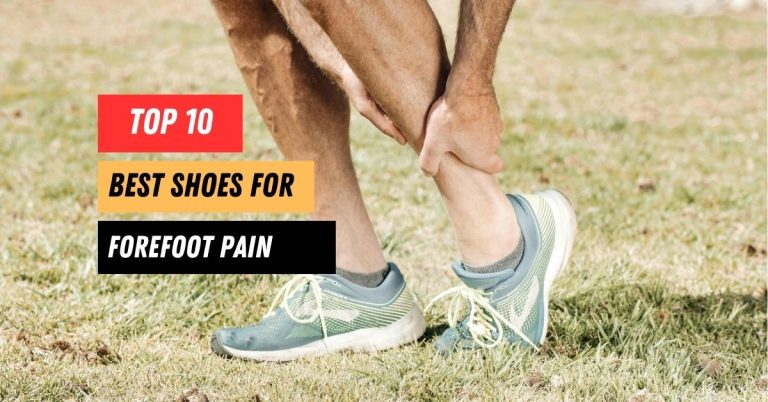10 Best Shoes After Broken Foot
Choosing the right shoes after a broken foot is not just about comfort it’s a crucial part of the recovery process. The correct footwear can significantly affect one’s safety and performance in daily activities, ensuring that the healing process is not only smooth but also swift. Post-injury, feet often require extra support to manage pain and prevent further injury. That’s why selecting shoes with optimal support, cushioning, and fit is essential.
This article will guide you through the process of finding the best shoes suited for post-fracture foot care, helping you step forward confidently and comfortably.
Top 10 Shoe Reviews for Recovery After a Broken Foot
Recovering from a broken foot requires not only patience and care but also the right footwear to ensure proper healing and support. Here are detailed reviews of the top 5 shoes that are most suitable for post-fracture foot care.
1. Orthofeet Orthopedic Sneakers
Orthofeet Orthopedic Sneakers are specifically designed to provide unparalleled comfort and support during the recovery from a foot injury. The first thing you’ll notice is the ergonomic design that eases foot motion and enhances stability. The shoes feature premium orthotic insoles alongside cushioning soles that soften steps and reduce pressure on the foot. They also boast a wide toe box and a non-binding upper which accommodate swelling and any orthotic inserts.
Over time, these sneakers can help alleviate pain not only in the feet but also in the hips and lower back, thanks to their excellent arch support. Furthermore, the sneakers come with a seam-free interior lining, which is essential for sensitive or injured feet, preventing irritation or blisters.
Pros:
-
Premium orthotic insoles enhance comfort.
-
Ergonomic sole with air cushioning.
-
Wide toe box and non-binding uppers.
-
Seam-free interior lining.
-
Designed to alleviate pain across the lower body.
Cons:
-
Higher price point than average sneakers.
-
Limited style and color options.
-
May feel bulkier than typical athletic shoes.
2. New Balance 990v5
The New Balance 990v5 stands out as a stellar choice for those recovering from a broken foot due to its perfect blend of stability and cushioning. Constructed with a durable blown rubber outsole and an ENCAP midsole technology, the 990v5 offers superior support and maximum durability.
The shoe’s dual-density collar foam ensures both flexibility and comfort, which is critical when dealing with foot mobility issues post-injury. Additionally, the breathable mesh upper works to keep the foot cool and dry, a necessity during long periods of wear. The New Balance 990v5 also features a spacious toe box and a lace-up closure for an adjustable fit, accommodating any swelling throughout the day.
Pros:
-
Excellent stability and support.
-
Durable construction with a blown rubber outsole.
-
Dual-density collar foam for comfort and flexibility.
-
Breathable mesh upper.
-
Spacious toe box.
Cons:
-
Some users may find the design too conservative.
-
Slightly heavier than some other models.
-
Price may be prohibitive for some budgets.
3. Propet Stability X Strap
Propet Stability X Strap shoes are tailored for those who need extra support during their recovery phase. These shoes feature a polyurethane outsole designed to deliver cushioning, traction, and durability. The hook-and-loop closure ensures that the fit can be easily adjusted, a beneficial feature for feet that are prone to swelling.
Inside, the shoes are fitted with gel insoles that provide additional cushioning and support, aiding in the reduction of pressure points around the underfoot. The mesh upper not only provides breathability but also adds to the lightweight feel of the shoe, making it ideal for everyday wear. Lastly, the simple yet functional design facilitates ease of use, especially for those with mobility challenges.
Pros:
-
Adjustable hook-and-loop closure.
-
Gel insoles for superior cushioning.
-
Lightweight mesh upper.
-
Durable polyurethane outsole.
-
Easy to put on and take off.
Cons:
-
Limited aesthetic appeal.
-
Not suitable for very narrow feet.
-
Some users report a lack of arch support.
4. Skechers Go Walk Joy
Skechers Go Walk Joy is the go-to shoe for comfortable post-injury recovery. These shoes are known for their Goga Max insole, which offers maximum support and high-rebound cushioning, essential for those recovering from a broken foot. The lightweight and flexible responsive 5GEN cushioning adapts to your walking style, providing effective pain relief and enhanced mobility.
The soft fabric lining and padded collar further enhance the comfort factor, making these shoes a pleasure to wear for extended periods. Additionally, the slip-on design with a pull-on loop makes the Go Walk Joy incredibly user-friendly, especially for those struggling with mobility or dexterity post-injury.
Pros:
-
High-rebound Goga Max insole.
-
Lightweight, flexible 5GEN cushioning.
-
Comfortable fabric lining and padded collar.
-
User-friendly slip-on design.
-
Available in various colors and styles.
Cons:
-
May not provide enough support for severe injuries.
-
The fit might be too loose for those with narrow feet.
-
Durability concerns over long-term use.
5. Brooks Addiction Walker
Brooks Addiction Walker shoes are ideal for those requiring exceptional support during the recovery from a foot fracture. The shoe features an extended progressive diagonal rollbar that naturally realigns the foot, significantly reducing strain on injured areas. The durable, energy-returning MoGo midsole offers a soft yet stable feel underfoot, which is critical during recovery.
The full-grain leather upper not only provides a secure fit but also gives the shoe a stylish look, suitable for both casual and formal wear. The strong traction outsole ensures safety on various surfaces, which is a significant concern post-injury.
Pros:
-
Extended progressive diagonal rollbar for foot realignment.
-
Energy-returning MoGo midsole.
-
Durable and stylish full-grain leather upper.
-
Strong traction outsole for safety on different terrains.
-
Suitable for both casual and formal wear.
Cons:
-
May feel stiffer than other recovery shoes.
-
Higher price point.
-
Limited breathability due to the leather upper.
6. Hoka One One Bondi 7
The Hoka One One Bondi 7 is renowned for its exceptional cushioning, making it a prime choice for those recovering from foot injuries. The shoe features a full EVA midsole, providing a plush feel underfoot that’s crucial for reducing impact during walking. The Meta-Rocker technology in the shoe is designed to help the natural walking gait, aiding those who may have mobility issues post-injury.
The breathable mesh upper ensures comfort during extended wear, and the padded collar prevents any irritation around the ankle. The Bondi 7’s wide base offers increased stability, reducing the risk of slips or falls—a key consideration for safety during recovery.
Pros:
-
Exceptional cushioning with a full EVA midsole.
-
Meta-Rocker technology aids natural walking motion.
-
Breathable mesh upper.
-
Wide base for increased stability.
-
Padded collar for added comfort.
Cons:
-
Some might find the shoe too bulky.
-
Higher price range.
-
Limited color options in some styles.
7. Asics Gel-Kayano 27
Asics Gel-Kayano 27 is an excellent choice for those needing enhanced foot support after a fracture. This model features Asics’ famous Gel technology, which provides superior shock absorption and comfort. The Dynamic DuoMax Support System enhances stability and support, while the FlyteFoam midsole technology offers exceptional bounce back and responsiveness, a boon for those in recovery needing to protect their feet from excessive strain.
The mesh upper is designed for optimal airflow, reducing moisture and increasing comfort. Additionally, the heel clutching system ensures a secure fit, crucial for maintaining proper foot alignment.
Pros:
-
Gel technology for shock absorption.
-
Dynamic DuoMax system for enhanced stability.
-
Responsive FlyteFoam midsole.
-
Breathable mesh upper.
-
Heel clutching system for secure fit.
Cons:
-
Can be expensive.
-
May have a narrow fit, not suitable for all foot types.
-
Some users find them less durable than expected.
8. Merrell Moab 2 Vent
The Merrell Moab 2 Vent is tailored for those who prefer outdoor activities but require sturdy and safe footwear during their recovery. This rugged shoe offers a Vibram outsole for unmatched durability and traction, essential for navigating uneven terrains. The suede leather and mesh upper provide durability and breathability, while the protective toe cap guards against bumps and scrapes.
An EVA midsole adds cushioning and stability, and the air cushion in the heel absorbs shock and adds stability, making these shoes ideal for those recovering from a broken foot who still wish to engage lightly in outdoor walks.
Pros:
-
Vibram outsole for excellent traction.
-
Durable suede leather and mesh upper.
-
Protective toe cap.
-
EVA midsole for cushioning.
-
Heel air cushion for shock absorption.
Cons:
-
Not as lightweight as other options.
-
May be too rugged for everyday use.
-
Requires breaking in to achieve optimal comfort.
9. Adidas UltraBoost 21
Adidas UltraBoost 21 is celebrated for its comfort and energy-returning properties, making it a suitable option for recovery footwear. The shoe features Adidas’ proprietary Boost midsole, which provides unmatched responsiveness and cushioning, essential for protecting a healing foot from harsh impacts.
The Primeknit upper wraps the foot for support and lightness, while the Stretchweb outsole with Continental Rubber offers superior grip, ensuring safety on both wet and dry surfaces. The shoe’s design also includes a supportive heel counter, which is crucial for keeping the foot stable during the healing process.
Pros:
-
Responsive Boost midsole.
-
Lightweight Primeknit upper.
-
Superior grip with Stretchweb and Continental Rubber outsole.
-
Supportive heel counter.
-
Stylish design and multiple color options.
Cons:
-
High price tag.
-
May not provide enough support for very serious injuries.
-
Fit might be too snug for swollen feet.
10. Clarks Unstructured Un.Loop
The Clarks Unstructured Un.Loop is an ideal shoe for those seeking both comfort and practicality in their recovery phase. This shoe is designed with a unique air circulation system that keeps feet cool and dry, essential for long-term wear. The full-grain leather provides durability, while the slip-on design makes for easy on-and-off a significant consideration for those with limited mobility.
The interior features a cushioned footbed that is designed to mold to the foot, providing tailored comfort and support. Additionally, the outsole offers good traction and flexibility, which helps in maintaining a natural walking motion during recovery.
Pros:
-
Unique air circulation system.
-
Durable full-grain leather.
-
Easy slip-on design.
-
Cushioned footbed that molds to the foot.
-
Good traction and flexibility.
Cons:
-
Some users may find the style outdated.
-
Limited color choices.
-
Not suitable for highly active use.
Buyer’s Guide
When recovering from a broken foot, the choice of footwear plays a pivotal role in the pace and quality of your rehabilitation. Here’s how to select the best shoes to aid in your recovery:
1. Support: Look for shoes that provide excellent arch support and a firm heel counter. After a fracture, your foot will need enhanced support to help distribute weight evenly and reduce pressure on the healing bones. Shoes with good support will stabilize the foot, reducing the risk of re-injury.
2. Comfort: Comfort is paramount when choosing shoes post-injury. The shoes should have a soft, seamless lining to avoid irritation and should accommodate any swelling. Features like extra depth and wide toe boxes can also be beneficial, allowing space for orthotics if prescribed by your healthcare provider.
3. Cushioning: Proper cushioning absorbs the impact while walking, which is crucial to protect your healing foot. Look for shoes with thick, soft soles made of materials like memory foam or polyurethane. This will help alleviate pain during the recovery process.
4. Adjustability: Shoes with adjustable straps or laces can accommodate changes in foot size due to swelling. This adjustability ensures that the shoe can provide a snug fit without being overly tight, which is important to avoid restricting circulation.
5. Material: Breathable materials such as soft leather or mesh work well to keep the foot cool and dry, preventing infections and discomfort. These materials also conform better to the foot’s natural shape, providing an extra layer of comfort.
6. Slip-resistant: Choose shoes with a non-slip outsole to prevent falls, especially when mobility is already compromised due to a broken foot. Rubber soles typically offer better traction and stability.
7. Durability: Since the recovery period can be extended, investing in durable shoes is wise. Durable shoes will maintain their supportive features over time, providing continuous benefits during your rehabilitation.
By considering these factors, you can choose shoes that not only comfort and protect your broken foot but also support your overall recovery journey.
FAQ
Q1: What type of shoe is best immediately after a foot fracture?
Immediately after a foot fracture, it’s best to wear orthopedic shoes or boots specifically designed for injury recovery. These shoes typically offer the necessary support, cushioning, and stability to protect the injured foot.
Q2: Can I wear regular sneakers after a broken foot?
While you might eventually return to wearing regular sneakers, it’s crucial to choose sneakers with exceptional support, cushioning, and a wide toe box during your recovery phase. Ensure they are adjustable to accommodate changes in swelling.
Q3: How long should I wear special footwear after a broken foot?
The duration depends on the severity of the break and your individual healing process. Consult with your healthcare provider for a personalized timeline, but it’s common to wear special footwear until you can walk without pain or discomfort.
Q4: Are there specific shoe brands recommended for use after a foot fracture?
Brands like Orthofeet, New Balance, and Propet are often recommended for their orthopedic features. These brands offer shoes designed to aid in recovery, providing necessary support and comfort.
Q5: What should I avoid in shoes after a broken foot?
Avoid shoes with hard soles, inadequate arch support, or those that are too tight. High heels and flip-flops are particularly detrimental as they offer little support and can lead to uneven weight distribution.
Q6: Is it okay to wear sandals after a broken foot?
If sandals are necessary, opt for orthopedic sandals with ample cushioning, arch support, and secure straps. Regular flat sandals are not advisable as they provide little support and stability.
Q7: Should I consider custom orthotics for my shoes after a broken foot?
Custom orthotics can be highly beneficial as they are tailored to address specific needs and assist in the alignment and support of your foot. Discuss with your podiatrist if custom orthotics might be suitable for your situation.
Conclusion
Selecting the right footwear post-broken foot is crucial for a safe and efficient recovery. The shoes reviewed here offer a range of features designed to provide stability, support, and comfort. Each option has unique benefits, catering to different recovery needs and activities, underscoring the importance of choosing footwear that ensures both safety and functionality during the healing process.







